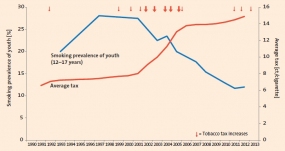What is the most effective way to prevent smoking in youth?
Young people in Germany between the ages of 12 and 17 smoke considerably less than in 2001: The rate of smokers among youth has dropped from 28 percent in 2001 to 12 percent in 2012. In a recent publication, the German Cancer Research Center (DKFZ) reports that the decline was the result of a number of legal measures that have had a substantial impact on tobacco use among young people.
“The considerable increases in the tax on tobacco between 2002 and 2005 in particular resulted in a significant decline in the percentage of smokers in this age group,” says Dr. Martina Pötschke-Langer, head of the Cancer Prevention Unit at the German Cancer Research Center (Deutsches Krebsforschungszentrum, DKFZ). She is editor of the most recent fact sheet “Tobacco prevention in Germany – what works?”. According to Pötschke-Langer, further declines followed the broad public debate on protection for non-smokers and the introduction of non-smoker protection legislation between 2007 and 2010. That period saw another significant drop in the percentage of smokers among youth: from 18 to 13 percent. Another effective measure was the change in youth protection laws, which initially raised the legal age for purchasing cigarettes to 16 years (2003) and finally to 18 (2007). The government’s concern about protecting youth from the dangers of smoking was further supported by larger warning labels on cigarette packages (*since 2002) and the tobacco advertising ban in print media and the Internet, enforced in 2007. In the most recent publication, a team of scientists led by Pötschke-Langer from DKFZ also studied the effect of prevention programs in schools. The latest evaluations revealed that school prevention programs in Germany reach only nine to 15 percent of students in the respective age groups and on the average only prevents or delays smoking initiation in one student per class. The scientists conclude that the small reach and low effectiveness of these programs have little impact on the smoking behavior of youth.
The tobacco industry in Ireland and the United Kingdom asserts that health education in Germany has been particularly successful and recommends that their governments should imitate this “German model.” However, the true aim of this “recommendation” is to counteract current plans for further regulation of the tobacco market, such as introducing standardized packaging. “The results of our study confirm the broad international scientific consensus about the effectiveness of considerable tobacco tax increases in changing the smoking behavior of youth,” says Martina Pötschke-Langer. “We emphatically reject the assertions made by the tobacco lobby that Germany’s successes are due to education programs. We hope that this publication will encourage governments to take further legal and regulatory measures that have an impact on the smoking behavior not only among youth but also in the population at large.”
The publication can be obtained from the Division of Cancer Prevention (who-cc@dkfz.de) and is available for download here.
With more than 3,000 employees, the German Cancer Research Center (Deutsches Krebsforschungszentrum, DKFZ) is Germany’s largest biomedical research institute. DKFZ scientists identify cancer risk factors, investigate how cancer progresses and develop new cancer prevention strategies. They are also developing new methods to diagnose tumors more precisely and treat cancer patients more successfully. The DKFZ's Cancer Information Service (KID) provides patients, interested citizens and experts with individual answers to questions relating to cancer.
To transfer promising approaches from cancer research to the clinic and thus improve the prognosis of cancer patients, the DKFZ cooperates with excellent research institutions and university hospitals throughout Germany:
The DKFZ is 90 percent financed by the Federal Ministry of Education and Research and 10 percent by the state of Baden-Württemberg. The DKFZ is a member of the Helmholtz Association of German Research Centers.


